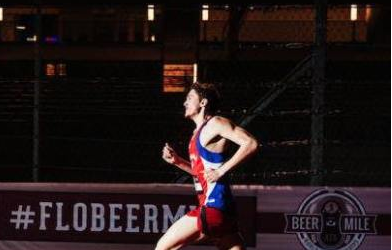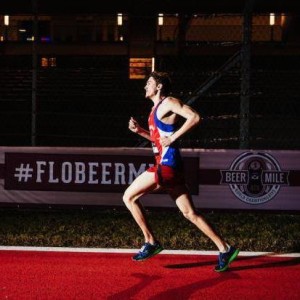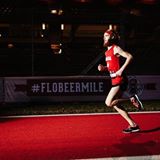How to run your fastest beer mile

We caught up with Lewis Kent, fifth in the world at the Beer Mile Championship elite race and Jeff Mountjoy, the sub-elite beer mile champion, for some advice about how they prepare. Kent is currently a student athlete at Western University in London, ON and Mountjoy is a former track captain of the Queen’s University team. He currently works at the university as a research assistant in their Computational Cognitive Neuroscience lab.
Drawing on their extensive knowledge, here is a list of important things to remember before beginning your beer mile training regimen.
Remember that it isn’t only about the alcohol
The beer mile is an event that relies on the ability of the competitor to drink and run fast, but it is important to remember that ‘drink’ means the literal action of consuming a liquid quickly. Even if beer isn’t your thing, you can try your hand with another drink—chocolate milk is often considered to be a non-alcoholic beverage of equivalent difficulty to chug. Though veteran beer miler, Jeff Mountjoy admits that, “I think using chocolate milk was perhaps harder than any beer mile I have ever run.”
To effectively train, you have to prepare your stomach to be able to hold that amount of fluid, regardless of its alcoholic content. If you run a beer mile with your friends, you may be surprised who comes out on top—it often isn’t the fastest runner, or the reputed drinker of the group, but the person with the ability to drink an entire water bottle before a run and not feel sloshy.
Lewis Kent trained his stomach before competing at the Beer Mile Championships by drinking water—“I would drink two bottles of water back to back in the morning, two in the afternoon, and usually another two after dinner. Drinking a lot of volume after big dinners definitely made it a lot easier to stomach four beers on race day.”
Train with a friend
Realistically, this is the sort of thing that is more fun to try out with a friend, preferably one who shares a love of running and drinking. It can be a very fun social event for running groups who, as Seanna Robinson pointed out, can’t help but getting competitive, even if the object is to ‘win the party.’
Specialize your workouts
 Kent: I trained in a couple of different ways. On top of regular training as a member of the Western XC team, I attempted a couple of beer workouts. I performed 400 and 200 meter repeats with beer recovery, also throwing in some strides after runs with beer recovery. Beer recovery means that the amount of rest that I got depended on the amount of time that it took me to drink the beer. A good amount of my training was done with non-alcoholic beer in order to get the volume and carbonation, without getting too drunk on a weeknight. Though I enjoy beer miling, I am still first and foremost a student!
Kent: I trained in a couple of different ways. On top of regular training as a member of the Western XC team, I attempted a couple of beer workouts. I performed 400 and 200 meter repeats with beer recovery, also throwing in some strides after runs with beer recovery. Beer recovery means that the amount of rest that I got depended on the amount of time that it took me to drink the beer. A good amount of my training was done with non-alcoholic beer in order to get the volume and carbonation, without getting too drunk on a weeknight. Though I enjoy beer miling, I am still first and foremost a student!
Mountjoy: Beer mile specific training, to me, has everything to do with the drinking. Running fitness does play an important part in running a fast beer mile, but my running training as a mid-distance runner translates perfectly to that.
The most common training exercise I perform is doing beer mile simulations, which consists of drinking four beers with a set amount of rest. Some people choose to take an amount of rest equal to their goal running pace, but others opt to do 30 seconds rest or less. In a recent simulation, my training partner Rob Asselstine was able to drink four regulation bottles in just under 40 seconds and I managed to drink four cans in 51 seconds.
Another challenge that has become highly competitive is the 6-6-60. To complete it, you have to drink six beers and run six miles (close to ten K) in the span of 60 minutes; the beers and miles can be completed in any order. In my fastest attempt, I drank two beers, ran four miles, drank my third beer, finished off the last two miles, and then drank three beers at the end with a final time of 48 minutes. Rob trumped me once again with an impressive time of 39 minutes.
As a final training exercise, I have attempted a couple times to chug a pitcher full of beer. A 60 oz pitcher is equivalent to five standard cans of beer. In my most recent two attempts, I managed times of 81 and 62 seconds. Chugging a pitcher doesn’t necessarily have direct relevance to a beer mile, but being able to handle the volume helps as a confidence boost.
Choose your beer wisely
Seanna said that one of her biggest rookie mistakes at the Beer Mile Championships was that she wasn’t prepared for the taste of that particular beer. Regardless of whether your drink is alcoholic or not, temperature is important—not too warm and not too cold is the best for quick drinking.
We recommend not using your favourite beer, you know, just in case you have to experience it a second time at the end of the race!


